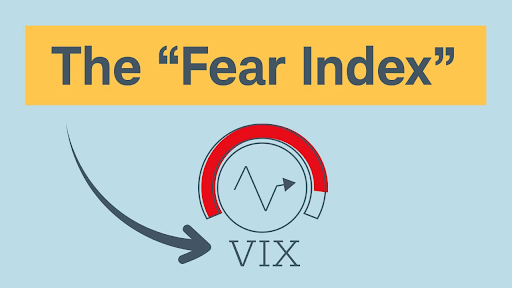
What is VIX index?
The VIX, or Volatility Index, is a handy tool for gauging market risk and understanding short-term market fluctuations. Essentially, it’s a real-time measure that reflects how much volatility traders expect for the S&P 500 in the near future, projecting this over the next 30 days based on SPX option prices.
Known as the "fear index," the VIX indicates anticipated market volatility and is expressed as a percentage. A rise in the VIX often suggests that the S&P 500 may be heading down, while a drop generally points to market stability and lower anxiety among investors.
"The VIX is such a fascinating tool—it really gives you insight into the market’s mood swings. But honestly, investing in it feels like walking a tightrope. Those ETFs and ETNs tied to VIX futures are cool, but they’re not for the faint of heart. If you’re not ready to monitor them constantly, they could do more harm than good. Definitely feels like a pro’s playground!"-, Myrosval Didukh, Trader at Fondexx
Source: www.schwab.com
What Does the VIX Really Tell Us?
Though it technically measures the volatility of the S&P 500, the VIX has become a broader gauge of market sentiment across the U.S. stock market. Options prices are a good proxy for volatility because when market worries increase, traders buy more options, which drives those prices up. That’s why the VIX is known as a fear indicator—it captures the level of tension or unease among investors.
Since we can’t predict market volatility exactly, the VIX is best used alongside historical data and analysis of support and resistance levels to get a fuller picture of market trends.
How it works?
The VIX reveals investor anxiety about future market movements. When its readings cross certain thresholds, it indicates either a heightened sense of calm or, on the flip side, a strong sense of panic among traders. By gauging the current level of market fears, investors can get a sense of where market sentiment—and possibly prices—are headed.
The VIX scale ranges from 0 to 100. When volatility is low, the index hovers close to zero, though it never quite reaches it. During times of intense market stress, the VIX tends to climb closer to 100, signaling increased uncertainty and potential turbulence ahead.
What VIX depends on?
The volatility indicator, based on S&P 500 data, is shaped by the prices of S&P 500 options. There’s an inverse relationship between the S&P 500 and the VIX, meaning that when the S&P 500 peaks, the VIX usually hits lows, and vice versa. This pattern often results from traders’ concerns, which can spark major market changes.
In periods of smaller fluctuations, markets feel more predictable, which typically boosts asset prices. While this inverse link between the indices is strong, it isn’t foolproof. The VIX, also known as the “fear index,” is driven by factors like:
- Market expectations, influenced by various conditions
- Release of significant news
- Reversals in market trends
- Financial crises.
During long-term trends, volatility often decreases, sometimes lulling traders into a sense of security. The VIX stands out because it’s based on forward-looking expectations rather than concrete historical data, making it difficult to calculate using fixed mathematical or statistical formulas. Because of this, some analysts question its reliability.
The VIX CBOE index levels are generally divided into three ranges:
- 0-20: Market volatility is quite low, indicating strong optimism among investors, and the S&P 500 is typically trending upward.
- 20-30: Investor concerns begin to rise, which leads to increased volatility. While the S&P 500 may continue its upward trend, there’s also a chance it could shift direction.
- 30-100: This range signals investor panic. Volatility is especially high, often pointing to a sharp correction or even a significant drop in the S&P 500 and other major stock indices.
Source: blueberrymarkets.com Volatility index
So, now we know a lot of theory behind the VIX, but for us as investors, the question could remain, is it possible to invest in it, and in case of yes, - how to do it?
Of course yes, it is possible.
The main way to trade the VIX is to buy exchange-traded funds (ETFs) and exchange-traded notes (ETNs) tied to the VIX.
VIX-based ETFs and ETNs don’t directly track the spot VIX. Instead, they rely on VIX futures to reflect market expectations of future volatility. While these products attempt to follow VIX trends, they often fall short of mirroring its real-time performance, focusing more on future volatility than the immediate market conditions.
Popular VIX-based Products
- iPath Series B S&P 500 VIX Short-Term Futures ETN (VXX): This ETN focuses on short-term volatility but is impacted by "negative roll yield" (backwardation), which harms long-term returns. While it may perform well in the short run, it's not ideal for long-term investments.
- iPath Series B S&P 500 VIX Mid-Term Futures ETN (VXZ): This product tracks mid-term volatility futures, making it less volatile than VXX, but still vulnerable to periods of low volatility.
- ProShares VIX Mid-Term Futures ETF (VIXM): This ETF focuses on futures contracts with an average of five months to expiration, making it suitable for those looking to profit from rising S&P 500 volatility.
- ProShares Short VIX Short-Term Futures ETF (SVXY): An inverse ETF that aims to profit from the opposite movement of the VIX. This is a higher-risk product meant for short-term, active traders rather than those looking to hold long-term.
Unique Risks of VIX Investments
Since these ETFs and ETNs don’t directly track the spot VIX, there’s often a lag between the VIX’s actual movement and these products. Timing is key, and even experienced investors can struggle to pinpoint the best entry and exit points.
Best for Short-Term Plays
VIX-related products are generally better suited for investors with short-term goals who are able to closely monitor their positions. These instruments can be highly volatile, so quick decisions are necessary to navigate potential risks.
Convenience with Caution
Although VIX ETFs and ETNs offer an easy way to trade volatility, they come with significant risks and limitations. They act like regular stocks but require careful attention and an understanding of their inherent flaws to use effectively.
Some history.
A pivotal moment in market history occurred two decades ago today, though it went largely uncelebrated. Back in January 1993, the Chicago Board Options Exchange (Cboe) introduced a new gauge to measure expected stock market volatility using options prices. Professor Bob Whaley, who created this metric while on a six-month break in France, developed what we now know as the VIX, or "fear index." Its original version, however, was quite basic. It focused only on S&P 100 options, had some quirks in the calculation that made it less reliable, and—crucially—was not something traders could actually trade. It was just a figure on the screen.
Then, on September 20, 2003, the modern VIX as we know it was launched, thanks to a collaborative team from Goldman Sachs and Cboe. The new VIX was now based on S&P 500 options and included improved methodology, making it possible to introduce futures (and eventually options) linked to the VIX itself. Key players in this transformation included Devesh Shah, Sandy Rattray, and Tim Klassen from Goldman, along with Joe Levin, John Hiatt, and Bill Speth from Cboe’s research and development team.
